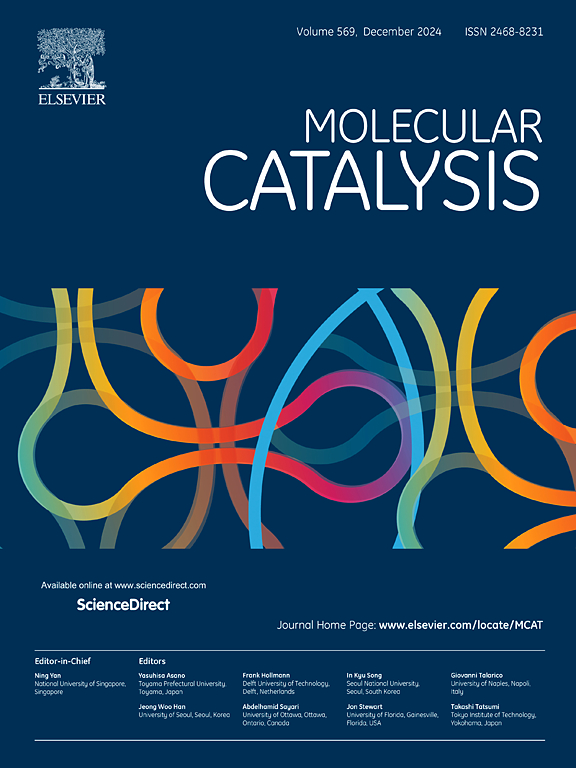Efficient biosynthesis of Pro-Xylane through semi-rational engineering of carbonyl reductase from Canariomyces notabilis
IF 3.9
2区 化学
Q2 CHEMISTRY, PHYSICAL
引用次数: 0
Abstract
Pro-Xylane (boseine), a key cosmetic ingredient renowned for its anti-wrinkle effects and bioaffinity, has drawn considerable attention for its efficient biosynthesis. In this study, a NADP(H)-dependent carbonyl reductase from Canariomyces notabilis (CnCR) was identified through in silico screening. Using alanine scanning and semi-saturation mutagenesis, the double mutant Y98K/N208Q was obtained, exhibiting a 15.8-fold increase in specific activity (60.11 U mg⁻¹) and an 11.5-fold improvement in catalytic efficiency (kcat/Km = 0.25 mM⁻¹ s⁻¹) compared to the wild-type enzyme. Mechanistic insights into the improved performance of Y98K/N208Q were revealed through molecular docking. In the enzyme-β-acetone xyloside complex, Y98K/N208Q showed enhanced hydrogen bonding and a refined active site, which improving substrate binding and anchoring. The shorter distance to NADPH and stronger interactions with the substrate boosted the mutant's catalytic efficiency compared to the wild-type. To enable efficient cofactor regeneration, glucose dehydrogenase from Bacillus amyloliquefaciens was integrated into the Y98K/N208Q-mediated Pro-Xylane biosynthetic pathway. Under optimized conditions (30 °C, pH 7.5, 40 g L⁻¹ cells, and a co-substrate-to-substrate ratio of 1.5 : 1), the coupled system produced Pro-Xylane at a titer of 160 g L⁻¹ within 10 h, achieving a conversion rate and diastereomeric excess (S-enantiomer) of ≥99 %. To our knowledge, this is the highest reported Pro-Xylane production to date. This study highlights the discovery and semi-rational engineering of a novel enzyme for efficient Pro-Xylane biosynthesis, offering a robust platform for industrial-scale production of this valuable compound.

Canariomyces notabilis羰基还原酶半合理工程高效合成原木聚糖
亲木碱(boseine)是一种重要的化妆品成分,以其抗皱作用和生物亲和力而闻名,因其高效的生物合成而受到广泛关注。本研究从Canariomyces notabilis (CnCR)中鉴定了一种NADP(H)依赖性羰基还原酶。通过丙氨酸扫描和半饱和诱变,获得了双突变体Y98K/N208Q,与野生型酶相比,比活性增加了15.8倍(60.11 U mg⁻¹),催化效率提高了11.5倍(kcat/Km = 0.25 mM⁻¹)。通过分子对接揭示了Y98K/N208Q性能改善的机理。在酶-β-丙酮木糖配合物中,Y98K/N208Q表现出增强的氢键和精炼的活性位点,从而改善了底物的结合和锚定。与野生型相比,与NADPH的距离更短,与底物的相互作用更强,提高了突变体的催化效率。为了实现有效的辅助因子再生,我们将解淀粉芽孢杆菌的葡萄糖脱氢酶整合到Y98K/ n208q介导的Pro-Xylane生物合成途径中。在优化条件下(30°C, pH 7.5, 40 g L -⁻¹细胞,共底物与底物的比例为1.5:1),偶联体系在10小时内产生了滴度为160 g L -⁻¹的Pro-Xylane,转化率和非对映体过量(s -对映体)≥99%。据我们所知,这是迄今为止报道的最高的Pro-Xylane产量。这项研究强调了一种新型酶的发现和半合理的工程设计,用于高效的Pro-Xylane生物合成,为这种有价值的化合物的工业规模生产提供了一个强大的平台。
本文章由计算机程序翻译,如有差异,请以英文原文为准。
求助全文
约1分钟内获得全文
求助全文
来源期刊

Molecular Catalysis
Chemical Engineering-Process Chemistry and Technology
CiteScore
6.90
自引率
10.90%
发文量
700
审稿时长
40 days
期刊介绍:
Molecular Catalysis publishes full papers that are original, rigorous, and scholarly contributions examining the molecular and atomic aspects of catalytic activation and reaction mechanisms. The fields covered are:
Heterogeneous catalysis including immobilized molecular catalysts
Homogeneous catalysis including organocatalysis, organometallic catalysis and biocatalysis
Photo- and electrochemistry
Theoretical aspects of catalysis analyzed by computational methods
 求助内容:
求助内容: 应助结果提醒方式:
应助结果提醒方式:


